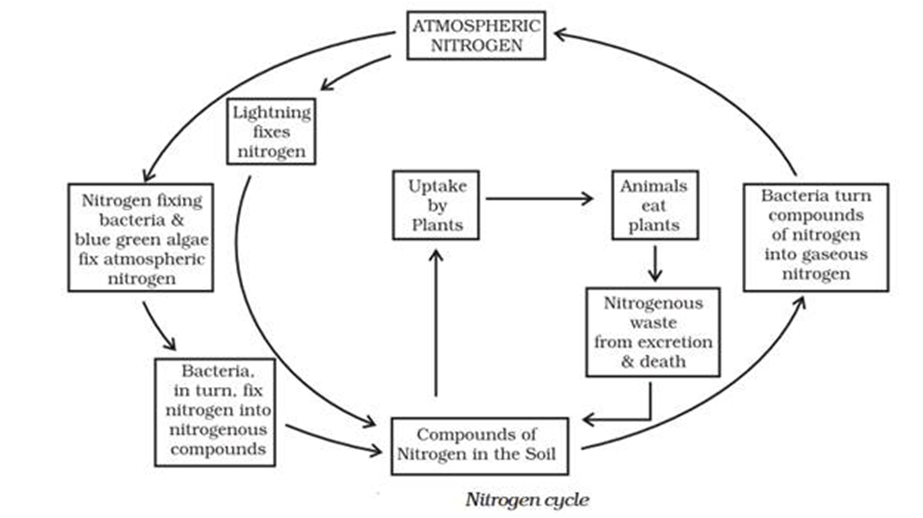Q 1 – What is the name of the undesirable plants that grow among the crops?
Ans – Weeds
Q 2 – What is a crop?
Ans – Crop is the term used to describe a plant that is grown in a field on a large scale. For example, cereal crops, wheat crops.
Q 3 – What is the process of loosening and turning of the soil called?
Ans – Tilling or ploughing
Q 4 – Name one weed.
Ans – Wild oat
Q 5 – Name the methods applied for weeding.
Ans-
- Manual method
- Chemical method
- Biological method
Q 6 – What are Bacteria?
Ans –
- Bacteria are single celled microbes.
- The cell structure is simpler than that of other organisms as there is no nucleus or membrane bound organelles.
- The control centre containing the genetic information is contained in a single loop of DNA.
- Some bacteria have an extra circle of genetic material called a plasmid. The plasmid often contains genes that give the bacterium some advantage over other bacteria.
- For example it may contain a gene that makes the bacterium resistant to a certain antibiotic.
Q 7 – Name the chemicals that are used to remove weeds.
Ans – Weedicides
Q 8 – What do you mean by the term agricultural practice?
Ans – Agricultural practices are those practices that involve the necessary steps to be taken during the production of crops.
Q 9 – What is the process of loosening and turning of the soil called?
Ans – Tilling or plowing
Q 10 – What are the substances which are added to the soil in the form of nutrients called?
Ans – Manure and fertilizers
Q 11 – What are the sources of irrigation?
Ans – Wells, tubewells, ponds, lakes, etc
Q 12 – Explain the term leveling.
Ans – Levelling is the process of breaking down the larger lumps of soil, and then leveling them by using a leveler.
Q 13 – What is the process of separation of grain from chaff called?
Ans – Winnowing
Q 14 – Name a disease caused by food poisoning.
Ans – Botulism
Q 15 – Name the ideal months for the harvesting of rabi crops.
Ans – March/April
Q 16 – What is the difference between refrigeration and freezing?
Ans – In refrigeration, the storing of the food is done at a temperature of 0°C to 5°C, whereas freezing is used to store food at -18°C of temperature.
Q 17 – Name two Kharif crops.
Ans – Soybean, groundnut
Q 18 – What are the advantages of leveling?
Ans – Following are the advantages of leveling:
- Leveling helps to prevent soil erosion caused by wind or air.
- It helps sow the seeds uniformly, and thus helps the plants to grow uniformly too.
- It helps in proper irrigation by allowing the water to get distributed uniformly throughout the soil.
Q 19 – Name any two fertilisers
Ans – NPK, Diammonium phosphate.
Q 20 – Name the type of microorganism that is smaller than bacteria.
Ans – Virus
Q 21 – What is a plough?
Ans – A plough is equipment for ploughing. It is mainly made of a wooden shaft called a plough-shaft, attached to a triangular iron blade called ploughshare.
Q 22 – What does yeast produce during respiration?
Ans – Yeast produces carbon dioxide gas during respiration.
Q 23 – What are pathogens? Write another name of pathogens.
Ans – Disease-causing microorganisms are known as pathogens. They are also called germs.
Q 24 – Explain the term transplantation.
Ans – Some of the crops are first grown in the nurseries and then transferred to the main field. This process is known as transplantation.
Q 25 – Write the names of any two antibiotics.
Ans – Streptomycin, Erythromycin
Q 26 – What are the advantages of manure?
Ans – Following are some advantages of manure:
- It enhances water-holding capacity of soil.
- It improves soil quality.
- It promotes the growth of soil friendly microbes.
- It is renewable, biodegradable and eco-friendly
Q 27 – What are weedicides? Give some examples.
Ans – Weedicides are chemicals that are used to remove weeds. Some commonly used weedicides are 2, 4-D, and metaphor.
Q 28 – What do you mean by the term crop? Explain briefly the types of crops.
Ans – Crop is the term used to describe a plant that is grown in a field on a large scale. For example, cereal crops, pulses and fruit crops.
The crops grown in India can be classified as kharif and rabi.
Kharif crops are sown in the rainy season by June/July and are harvested by September/October. Thus they are also known as summer season crops. For example, rice, maize, etc. Rabi crops are sown in the winter season in October or November and are harvested by March/April. Thus, they are also called winter season crops. For example, mustard, wheat, potato, etc.
Q 29 – Classify bacteria on the basis of their shapes.
Ans – On the basis of their shapes, bacteria are classified into four categories:
- rod-shaped bacteria (bacilli)
- spherical-shaped bacteria (cocci)
- curved-shaped bacteria (vibrios)
- spiral-shaped bacteria (spirilla)
Q 30 – What is ploughing or tilling? State its advantages.
Ans – The process of loosening and turning the soil is called tilling or ploughing. This is done by using a plough.
- Ploughs are made of wood or iron.
- Following are the advantages of ploughing or tilling:
- Ploughing loosens the soil and makes it aerated.
- It helps in mixing organic matter with the soil uniformly.
- It initiates the growth of natural agents and microorganisms and thus, keeps the soil fertile.
- It increases the water holding capacity of soil.
- It helps in easy penetration of root into the soil.
Q 31 – Differentiate between viruses and other microorganisms.
Ans –
| Viruses | Other microbes |
| (i) They show the characteristics of living organisms or reproduce only by entering the host organisms. (ii) They are non-cellular microbes. | (i) They do not need to enter any host organism to reproduce or show any characteristics of life. (ii) They are cellular microbes. |
Q 32 – Define the term agricultural practices and also state the important steps taken during crop production.
Ans – Agricultural practices are those practices that involve the necessary steps to be taken during the production of crops. There is a number of steps of crop production which are to be done very carefully to ensure that crops get produced in a timely.
Some of the most important steps taken during crop production are as under:
Soil preparation Sowing Adding manure and fertilisers Irrigation Weeding Harvesting Threshing and winnowing Storage of grains
Q 33 – What is irrigation? Name the two main methods of irrigation and define them briefly.
Ans. The artificial method of watering the plants for assisting in the growth of the plants is called irrigation. The two main methods of irrigation are:
- Traditional method: The traditional method of irrigation is very less expensive and they often lead to wastage of water. Traditional method of irrigation involves chain pump, dhekli, moat (the pulley system) and rahat (lever system).
- Modern method: Modern methods of irrigation are more inclined towards the use of diesel, biogas, solar energy and electricity for lifting water. The two most important modern system of irrigation are:
Sprinkler irrigation system Drip irrigation system
Q 34 – How are carriers harmful to us?
Ans – Carriers take with them many harmful microorganisms or pathogens. They play a great role in transferring these pathogens to a healthy person, by sitting on the food items or directly transferring the pathogens inside the body of a person. Hence they are harmful to us.
Q 35 – What do you mean by immunity?
Ans – Immunity is the ability of a body to develop resistance against diseases.
Q 36 – What do you mean by weeding? Why is the process of weeding necessary? Name the methods applied for weeding.
The undesirable plants that grow among the crops are called weeds. The process of removing these weeds is known as weeding. Weeds compete with the crop plants for nutrients and space. They grow much rapidly than the crop plant. So weeding is necessary. Methods applied for weeding are as follows:
Ans –
- Manual method: Manual method of removing weeds is the most time consuming method. In this system weeds are controlled by hand pulling, digging, shallow tillage, etc., by using certain implements like khurpi, hoe, etc.
- Chemical method: In this method chemicals called, weedicides are used to remove weeds. For example, metachlor and 2, 4-D.
- Biological control method: This method is the most commonly used method of weed control. It involves the use of some speci¦c insects that destroy the growth of some specific weeds. For example, leafy spurge, a weed, is controlled by using flea beetles.
Q 37 – What are antibodies?
Ans – Whenever any harmful disease-causing microorganism enters the human body, the body produces substances to fight with the entered microbe. These substances are called antibodies.
Q 38 – What is the role of bacteria in increasing soil fertility?
Ans Some bacteria, which are present in the root nodules of leguminous plants or free-living fix the atmospheric nitrogen in the soil which is ultimately used up by the plants. Hence they increase the fertility of the soil. For example, Rhizobium, Azotobacter, Azospirillum, etc.
Q 39 – Write short note on the terms:
- Storage
- Harvesting
Ans –
- Storage: Storage of produce is an important task. If the crop grains are to be kept for longer time, theyshould be safe from moisture, insects, rats and microorganisms. Before storing, the grains are
properly dried in the sun to reduce the moisture in them. This prevents the attack by insect pests,bacteria and fungi. Grains are stored by farmers in jute bags or metallic bins. However, large scale
storage of grains is done in silos and granaries to protect them from pests like rats and insects. - Harvesting: After maturation of crop, harvesting is an important task. In harvesting, crops are pulled out or cut close to the ground. It usually takes 3 to 4 months for a cereal crop to mature. Harvesting in our country is either done manually by sickle or by machine called harvester.
Q 40 – What is sterilization?
Ans – The process of killing all the microorganisms above the temperature of 100°C is known as sterilization. It is one of the widely used methods to preserve food and is often used for various food items.
Q 41 – What is pasteurisation?
Ans – Pasteurisation can be defined as the partial sterilization of foods at a temperature that destroys harmful microorganisms without major changes in the chemical property of the food.
Q 42 – Why the depth at which seeds are planted is important?
Ans – If the seed is planted too deep then it will not get enough sunlight to germinate. If the seed is planted too shallow then it will not get enough soil to support germination. The depth for sowing seed also depends upon the seed size.
Q 43 – How can we control the spread of malaria or dengue ?
Ans – All mosquitoes breed in water. Hence, by keeping the surroundings clean and dry, we can prevent mosquitoes from breeding. We should not allow water to collect in coolers, flower pots, etc. We should wear full sleeves shirts in the evenings and at night. We can also use mosquito repellant creams and mosquito nets.
Q 44 – Why sowing seeds with seed drill is better than broadcasting?
Ans – Seed drill sows the seeds uniformly at proper distances and depths, whereas broadcasting of seeds scatter
them non-uniformly on the ground surface which are susceptible to be picked up by birds.
Q 45 – Name of Algae which helps in nitrogen-fixing?
Ans –Anabaena is a Blue-Green alga. It is a unicellular prokaryotic organism. It does not have membrane-bound organelles or a true nucleus. It is used as nitrogen-fixing bacteria. It fixes atmospheric nitrogen into ammonia and makes it available to the plants.
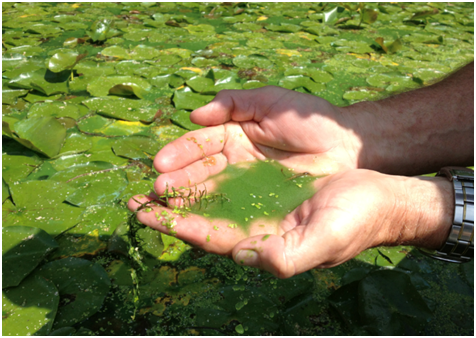
Q 46 – How to convert the lactose sugar into lactic acid?
Ans –These bacteria contain an enzyme called lactase which attacks lactose, splitting its molecules into glucose and galactose. Other enzymes from the lactic acid bacteria then attack the glucose and galactose, converting them into various acids of which lactic acid is the most important.
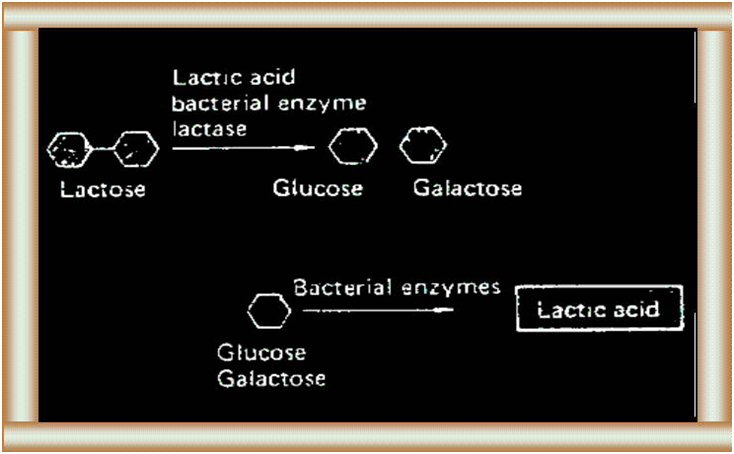
Q 47 – What is the biological control of pests? How is it beneficial?
Ans – Method of controlling pests including insects, mites, weeds, etc., with the help of other living organisms are known as biological control of pests. The controlling agents are very much particular about their host pests. For example, ladybugs control aphids, mites, scale insects, etc., which harm the cr ps. A wasp eats up bollworms or other caterpillars on the cotton plants. Benefits of biocontrol agents are:
- Less costly
- Give protection to the crop throughout the crop period
- Eco-friendly
- Harmless to human beings and beneficial to flora and fauna
Q 48 – Mention any three ways through which pathogens are transmitted.
Ans – Three ways because of which pathogens are transmitted are as follows:
1. When a person sneezes or coughs, tiny droplets containing a number of disease-causing microorganisms come out of the mouth and are released in the air. They are transmitted to a healthy person while breathing.
2. By making direct contact with an infected person, pathogens are transferred to a healthy person. Carriers of pathogens also help in their transmission. For instance, when a fly sits on animal excreta or garbage, harmful disease-causing microbes stick to its legs.
3. When this fly sits on the food items, pathogens get transferred to them. This contaminated food items cause serious diseases when it is eaten by a healthy person.
Q 49 – Explain canning.
Ans – Canning is a process used for food preservation. Heat, at a certain temperature and for a limited period of time, is used to kill harmful microorganisms as well as enzymes. This method also involves the removal of oxygen gas, and avoiding post-process contamination by airtight sealing of food items.
Q 50 – Explain how malaria is transmitted to humans.
Ans –
- A protozoan called Plasmodium is responsible for malaria.
- It lives in the liver and blood of the person who has been infected by this disease.
- A female Anopheles mosquito when sucks blood from the infected person, Plasmodium along with blood, is taken into its stomach.
- The Plasmodium, here, multiplies itself and reaches the salivary gland of the mosquito.
- This mosquito bites a healthy person, it injects Plasmodium along with saliva to him. The healthy person then gets an attack of malaria. In this way, malaria is transmitted to humans.
Q 51 – Explain various types of bacteria.
Ans – Bacteria are classified on the basis of their shapes into the following categories:
- Rod-shaped bacteria (bacilli):These are aerobic rod-shaped, spore-producing bacteria. They are often occurring in chain-like formations, and they are found primarily in soil; e.g., Lactobacillus.
- Spherical-shaped bacteria (cocci): They are spherical or nearly spherical bacteria; e.g., Streptococcus.
- Curved-shaped bacteria (vibrios): They are curved-shaped bacteria; e.g., Vibrio.
- Spiral-shaped bacteria (spirilla): They are flagellated, aerobic bacteria, having a spirally twisted rod-like form; e.g., Treponema.
Q 52 – What are the various diseases caused by Protozoa?
Ans – Protozoan infections are responsible for diseases that affect many different types of organisms, including plants, animals, and some marine life. Many of the most prevalent and deadly human diseases are caused by a protozoan infection, including African sleepingn sickness, amoebic dysentery, and malaria.

Giardia lamblia, an infectious protozoan
Q 53 – Define Algae?
Ans – Algae is an informal term for a large and diverse group of photosynthetic eukaryotic organisms. It is a polyphyletic grouping that includes species from multiple distinct clades. Included organisms range from unicellular microalgae, such as Chlorella, Prototheca, and the diatoms, to multicellular forms, such as the giant kelp, a large brown alga that may grow up to 50 meters (160 ft) in length. Most are aquatic and autotrophic and lack many of the distinct cell and tissue types, such as stomata, xylem, and phloem, which are found in land plants. The largest and most complex marine algae are called seaweeds, while the most complex freshwater forms are the Charophyta, a division of green algae which includes, for example, Spirogyra and stoneworts.
“have chlorophyll as their primary photosynthetic pigment and lack a sterile covering of cells around their reproductive cells”. Although cyanobacteria are often referred to as “blue-green algae”, most authorities exclude all prokaryotes from the definition of algae. Algae constitute a polyphyletic group since they do not include a common ancestor, and although their plastids seem to have a single origin, from cyanobacteria, they were acquired in different ways. Green algae are examples of algae that have primary chloroplasts derived.
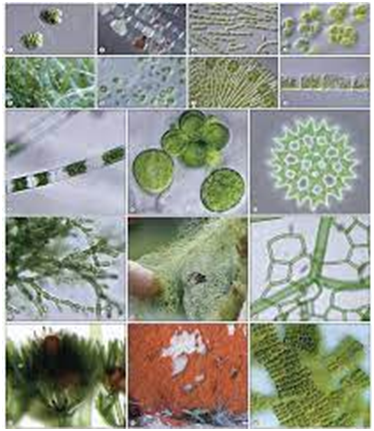
A variety of microscopic unicellular and colonial freshwater algae
Q 54 – Define Fungi.
Ans – Fungi (singular: fungus) are a kingdom of usually multicellular eukaryotic organisms that are heterotrophs (cannot make their own food) and have important roles in nutrient cycling in an ecosystem. Fungi reproduce both sexually and asexually, and they also have symbiotic associations with plants and bacteria. However, they are also responsible for some diseases in plants and animals. The study of fungi is known as mycology.
which are branching filaments. Hyphae have a tubular shape and are split into cell-like compartments by walls that are known as septa. These cells can have more than one nucleus, and nuclei and other organelles can move in between them.

Q 55 – What are the saprophytes and parasites?
Ans –
i) Saprophyte: The organisms which obtain their food from dead plants (like rotten leaves), dead and decaying animal bodies, and other decaying organic matters (like rotten bread) are known as saprophytes.
Example: Fungi and some bacteria.
ii) Parasite: The organisms which feed on another living organism called its host are known as parasites.
Example: Plasmodium and roundworm.
Parasites are those organisms that obtain their nutrition from other living organisms, whereas saprophytes obtain their nutrition from the dead decaying organic matter.
Q 56 – Name any two human diseases caused by Fungi?
Ans – Disease caused by fungi
Explanation:
Fungi cause three different types of human illness: poisonings, parasitic infections, and allergies. Many poisonous mushrooms are eaten by mistake because they look like edible mushrooms. Parasitic yeasts cause candidiasis, ringworm, and athlete’s foot. Mold allergies are very common.
- Ringworm is caused by a type of fungus that eats keratin. These are called dermatophytes. The scientific names for the types of fungi that cause ringworm are Trichophyton, Microsporum, and Epidermophyton.
- Candidacies is a fungal infection typically on the skin or mucous membranes caused by candida.
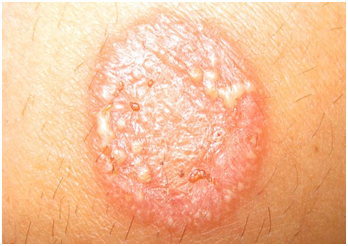
Ringworm infection
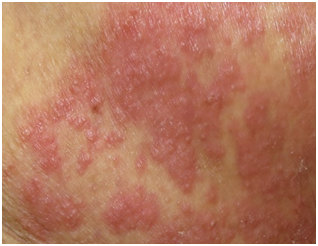
Candidacies infection
Q 57 – Where do microorganisms live?
Ans –
Microorganisms may be single-celled like bacteria, some algae and protozoa, or multicellular such as algae and fungi. They can survive under all types of environment, ranging from ice cold climate to hot springs and deserts to marshy lands. They are also found inside the bodies of animals including humans. Some microorganisms grow on other organisms while others exist freely. Microorganisms like amoeba can live alone, while fungi and bacteria may live in colonies.
- Microorganisms have a ubiquitous presence. They are present everywhere in the land, water, and air. They have a high degree of adaptability and can survive in all kinds of environments, like hot springs, ice-cold water, etc.
- They are also present in our body and in dead and decomposed organic matter. Some of them may be parasitic.
- Microorganisms are omnipresent, they are found everywhere. They live in every nook and corner you could possibly imagine. On your seat, under the table, over the roof, even on your body parts, your palms, literally everywhere. They also dwell in extreme weather conditions like the equator, poles, deserts, ice-cold water bodies, hot boilers etc and adapt accordingly.

Q 58 – What are the uses of microorganisms?
Ans – Microorganisms are too small to be seen through naked eyes. However, they are vital to plants and the environment. Given below are the few uses of microorganisms:
- Lactobacillus is used to form curd from milk.
- Rhizobium present in pulse plants’ roots fix nitrogen from the air and supply nitrogen compounds to the pulse plants.
- Micro-organisms are also used in winemaking, baking, pickling, and other food-making processes.
- Alcoholic fermentation by yeast is widely used in the preparation of wine and bread.
- Microbes are used to reduce pollution. For example, decomposers such as bacteria and fungi break down dead bodies and excreta to form inorganic compounds, which plants can absorb.
- Microbes also play an important role in the preparation of medicines. Antibiotics are chemicals produced by microorganisms to kill bacteria. Penicillin is an antibiotic made from Penicillium.
- Bacteria in our intestine helps in proper digestion and release vitamin B, absorbed by the intestine.
- Many vaccines are prepared from micro-organisms. These vaccines are given to children to protect them from the disease.
- Certain microbes are also used in the biological treatment of sewage and industrial effluents.
- Yeast is used in making idli, bhaturas, bread, pastries, and cakes.
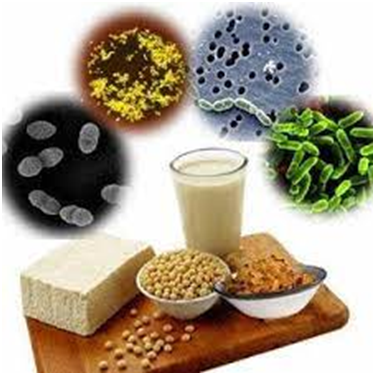
Q 59 – How milk is convert into curd?
Ans – Milk is converted into curd or yogurt by the process of fermentation. Milk consists of globular proteins called casein. Here curd forms because of the chemical reaction between the lactic acid bacteria and casein. During fermentation, the bacteria use enzymes to produce energy (ATP) from lactose. The byproduct of ATP production is lactic acid. Lactic acid acts on the globular proteins present in the milk and denatures them. This denaturation destroys the tertiary and quaternary structures of proteins and the globular proteins are converted into fibrous proteins thus giving a thick texture to the milk due to coagulation of the proteins.
Q 60 – How yeast is used for making bread?
Ans –Yeast is used for the leavening of bread. Yeast uses the sugars and oxygen in the dough to produce more yeast cells and carbon dioxide gas. … Yeast uses sugars by breaking them down into carbon dioxide and water. The yeast needs lots of oxygen in order to complete this type of fermentation.
Baker’s yeast is the common name for the strains of yeast commonly used in baking bread and bakery products, serving as a leavening agent which causes the bread to rise (expand and become lighter and softer) by converting the fermentable sugars present in the dough into carbon dioxide and ethanol.
Or
Yeast is used for the leavening of bread.
Yeast uses the sugars and oxygen in the dough to produce more yeast cells and carbon dioxide gas.
The carbon dioxide makes the dough rise which gives the bread light and spongy texture.

Q 61 – Define fermentation?
Ans – Fermentation is the process of food processing in which sugar is converted into alcohol by the action of microorganisms. This process is used to produce alcoholic beverages such as wine, beer, and cider.
Fermentation is the breakdown of organic substances by organisms to release energy in the absence of oxygen. For example – The anaerobic breakdown of carbohydrates by yeasts to produce alcohol and carbon dioxide, and the bacterial breakdown of milk sugar to give lactic acid.
Types of Fermentation
There are three different types of fermentation:
- Lactic Acid Fermentation: In this, starch or sugar is converted into lactic acid by yeast strains and bacteria. During exercise, energy expenditure is faster than the oxygen supplied to the muscle cells. This results in the formation of lactic acid and painful muscles.
- Alcohol Fermentation: Pyruvate, the end product of glycolysis is broken down into alcohol and carbon dioxide. Wine and beer are produced by alcoholic fermentation.
- Acetic Acid Fermentation: Starch and sugar present in grains and fruits ferment into vinegar and condiments. E.g. apple cider vinegar.
Q 62 – How vinegar is converted into alcohol?
Ans – Vinegar is made from a two-step fermentation process. First, alcohol is formed from yeast consuming sugars within fruits and grains. The yeast consumes the natural sugars in the produce and excretes alcohol. This is what we refer to as alcoholic fermentation.
Vinegar is nothing but acetic acid. Alcohol can be converted into Acetic Acid by oxidation. This oxidation is done by various types of microorganisms mostly fungus. This process is known as fermentation. When fungus or anaerobic bacteria respire anaerobically then sugar is converted into alcohol. This alcohol upon exposure to air gets oxidized to form Acetic Acid. This acetic acid can be used For industrial purposes. To transform alcohol into vinegar, oxygen and a bacteria of the genus Acetobacter must be present for the second step to take place, acetic fermentation. These bacteria are found in all organic product that contains sugar, such as fruits and plant roots. A combination of these bacteria and an anaerobic environment causes acetification and thus, vinegar.
Q 63 – What are antibiotics?
Ans – Any substance that inhibits the growth and replication of a bacterium or kills it outright can be called an antibiotic. Antibiotics are a type of antimicrobial designed to target bacterial infections within (or on) the body. This makes antibiotics subtly different from the other main kinds of antimicrobials widely used today:
- Antiseptics are used to sterilise surfaces of living tissue when the risk of infection is high, such as during surgery.
- Disinfectants are non-selective antimicrobials, killing a wide range of micro-organisms including bacteria. They are used on non-living surfaces, for example in hospitals.
Of course, bacteria are not the only microbes that can be harmful to us. Fungi and viruses can also be a danger to humans, and they are targeted by antifungals and antivirals, respectively. Only substances that target bacteria are called antibiotics, while the name antimicrobial is an umbrella term for anything that inhibits or kills microbial cells including antibiotics, antifungals, antivirals, and chemicals such as antiseptics.
Most antibiotics used today are produced in laboratories, but they are often based on compounds scientists have found in nature. Some microbes, for example, produce substances specifically to kill other nearby bacteria in order to gain an advantage when competing for food, water, or other limited resources. However, some microbes only produce antibiotics in the laboratory
Q 64 – How did Alexander Discover the first antibiotic penicillin?
Ans – In 1929, Alexander Fleming was cultivation culture of disease-causing bacteria. Suddenly he found the spore of a green fungus in one of his culture plates. He noticed that the presence of tiny green fungus stopped the growth of disease-causing bacteria. In fact, it also killed many of the disease-causing bacteria. From the fungus called Penicillium, the medicine is made from the fungus penicillium. Penicillin controls bacterial and fungal infections.
Q 65 – How do vaccines help a person fight disease?
Ans – A vaccine contains the dead or weakened but alive microorganism of a disease. When the vaccine containing dead or alive microorganisms is introduced into the body of a healthy person orally or by injection, the body of the person responds by the production of some substances called antibodies in the blood. These antibodies kill any alive disease-causing microorganism presence in the vaccine. Some of the antibodies remain in the blood of the person for a very long time and fight against the same microorganism and kill them if they happen to enter the body naturally at a later date. So due to the presence of antibodies in the blood, a person remains protected from that particular disease. Thus a vaccine develops immunity from a disease.
Q 66 – What is vaccination?
Ans – A vaccine is a biological substance designed to protect humans from infections caused by bacteria and viruses. Vaccines are also called immunizations because they take advantage of our natural immune system’s ability to prevent infectious illnesses. To understand how vaccines work, we need to consider how our immune system protects us from infections.
Vaccination is a simple, safe, and effective way of protecting people against harmful diseases before they come into contact with them. It uses your body’s natural defenses to build resistance to specific infections and makes your immune system stronger.
Vaccines train your immune system to create antibodies, just as it does when it’s exposed to a disease. However, because vaccines contain only killed or weakened forms of germs like viruses or bacteria, they do not cause the disease or put you at risk of its complications.
Most vaccines are given by injection, but some are given orally (by mouth) or sprayed into the nose.
Q 67 – Who discovered vaccination?
Ans – The history of smallpox holds a unique place in medicine. It was one of the deadliest diseases known to humans, and to date (2016) the only human disease to have been eradicated by vaccination. The smallpox vaccine, introduced by Edward Jenner in 1796, was the first successful vaccine to be developed. He observed that milkmaids who previously had caught cowpox did not catch smallpox and showed that inoculated vaccine protected against inoculated variola virus.
Q 68 – What is recycling the nutrients?
Ans –The recycling of various nutrients takes place in the form of nutrient cycles. A nutrient cycle is a cyclic movement of nutrients from its major reservoir through different organisms back into the same reservoir. These cycles indicate the flow of nutrients in an ecosystem. A nutrient cycle (or ecological recycling) is the movement and exchange of organic and inorganic matter back into the production of matter. Energy flow is a unidirectional and non-cyclic pathway, whereas the movement of mineral nutrients is cyclic. Mineral cycles include the carbon cycle, sulfur cycle, nitrogen cycle, water cycle, phosphorus cycle, oxygen cycle, among others that continually recycle along with other mineral nutrients into productive ecological nutrition.
Components
Each nutrient cycle comprises of three components;
- Reservoirs: These are the major storage sites of a nutrient. Different organisms consume a nutrient from these reservoirs.
- Sources: These are the ways by which a nutrient is regenerated and added to its reservoirs.
- Sinks: They are the major consumption sites of a nutrient.
Q 69 – What are pathogens?
Ans – A pathogen is simply defined as an organism that has the potential to cause infectious diseases in its host. Most pathogens are able to avoid the immune responses of the host, triggering associated illnesses. The pathogen then utilizes the host body’s resources to replicate before exiting and spreading to a new host (like a virus).
Pathogens are of different types and can spread through various means usually skin contact, body fluids, or contact with contaminated surfaces. Some pathogens exist as airborne particles. The most common types of pathogens are viruses, bacteria, and fungi.
Diseases caused by pathogens are many. Common examples of viral pathogens include common cold, yellow fever, flu, dengue fever, etc.
Similarly, the diseases caused by bacterial pathogens are Urinary Tract Infection (UTI), tuberculosis, gonorrhoea, etc. The diseases caused by fungal pathogens are thrush, ringworm, etc.
Q 70 – What are communicable diseases?
Ans – A communicable disease is one that is spread from one person to another through a variety of ways that include: contact with blood and bodily fluids; breathing in an airborne virus; or being bitten by an insect.
Reporting of cases of communicable disease is important in the planning and evaluation of disease prevention and control programs, in the assurance of appropriate medical therapy, and in the detection of common-source outbreaks. California law mandates healthcare providers and laboratories to report over 80 diseases or conditions to their local health department. Some examples of reportable communicable diseases include Hepatitis A, B & C, influenza, measles, salmonella, and other foodborne illnesses. a communicable disease is one that is spread from one person to another through a variety of ways that include: contact with blood and bodily fluids; breathing in an airborne virus; or being bitten by an insect.
Q 71 – Name some of the examples of communicable diseases?
Ans – Some of the examples of communicable diseases are: Common cold, Cholera, Chickenpox, Tuberculosis (TB), Malaria, and AIDS.
Q 72 – What are the various way in which communicable diseases can occur the spread?
Ans – A communicable disease is one that is spread from one person to another through a variety of ways that include: contact with blood and bodily fluids; breathing in an airborne virus; or being bitten by an insect.
Reporting of cases of communicable disease is important in the planning and evaluation of disease prevention and control programs, in the assurance of appropriate medical therapy, and in the detection of common-source outbreaks. California law mandates healthcare providers and laboratories to report over 80 diseases or conditions to their local health department. Some examples of reportable communicable diseases include Hepatitis A, B & C, influenza, measles, salmonella, and other foodborne illnesses.
How these diseases spread depends on the specific disease or infectious agent. Some ways in which communicable diseases spread are by:
- physical contact with an infected person, such as through touch (staphylococcus), sexual intercourse (gonorrhea, HIV), fecal/oral transmission (hepatitis A), or droplets (influenza, TB)
- contact with a contaminated surface or object (Norwalk virus), food (salmonella, E. coli), blood (HIV, hepatitis B), or water (cholera);
- bites from insects or animals capable of transmitting the disease (mosquito: malaria and yellow fever; flea: plague); and
- travel through the air, such as tuberculosis or measles.
Q 73 – What is the carrier?
Ans – The insects ( or other animals) which transmit disease-causing microorganism to humans (without themselves suffering from them) is called Carrier.
Q 74 – Define food poisoning?
Ans – Food poisoning is a very common illness. For most people, it is usually mild, but food poisoning can be severe and even deadly for some individuals.
Most cases of food poisoning occur when people eat food or drink water containing bacteria, bacterial toxins (substances produced by bacteria), parasites, or viruses. Food poisoning can also occur when non-infectious poisons (such as poisonous mushrooms) or heavy metals (such as lead or mercury) find their way into people’s stomachs.
It is estimated that about 11 million Canadians experience food poisoning each year. People at greatest risk for food poisoning are seniors, pregnant women, young children and babies, and people with chronic medical conditions (e.g., diabetes, AIDS, liver disease).
Food poisoning occurs when contaminated food or water is ingested. Contamination can occur anywhere along the process of obtaining and eating food – it can occur during the growing, harvesting, processing, storing, or preparation stages. In most cases, bacteria, viruses, or parasites are transferred to food from other sources, making these organisms the most common cause of food poisoning. However, in some less common types of food poisoning, the poison or toxin is naturally part of the food (e.g., poisonous mushrooms or fish). Other less common causes include shellfish and insecticides.
Q 75 – Name of bacteria and fungus causing food poisoning?
Ans – Mouldy food can be dangerous to eat if the fungi growing on it are the kind that produces mycotoxins. These are formed as the branching network of fungal filaments (hyphae) spread through the food and breaks it down.
Molds can grow in drier environments than other microbes and mycotoxins are a problem in products such as nuts and cereals which have been stored in damp conditions. It’s easy to mistakenly process and eat contaminated food because it does not look spoilt.
- Aflatoxins – carcinogens found in mouldy nuts.
- Ochratoxins – cause kidney disease and are produced in cereals such as maize and barley.
- Patulin – associated with moldy apples and poisoning has arisen from drinking contaminated fresh apple juice.
Whilst some mushrooms are safe to eat and tasty, others, like the Death Angel, can be deadly.
Mushrooms and toadstools
These fruiting bodies of certain fungi have been part of the human diet for centuries. However, not all of them are edible.
Some, such as the aptly named Death Angel (Amanita bisporigera), contain poisonous compounds which can be lethal. Other species cause unpleasant effects: sickness, diarrhea, kidney and liver damage. Before you eat wild mushrooms you should have them checked for safety by an expert.
Q 76 – What are food preservation and the hour it can use done?
Ans – The process in which the food material is given a suitable physical or chemical treatment to prevent their spoilage is called food preservation.
- Sun drying( or Dehydration
- Heating
- Cooling (or Refrigeration)
- Deep freezing
- Addition of common salt
- Addition of sugar
- Addition of mustard oil and vinegar
- Use of special Chemical preservatives
- Pasteurization
- Packing food in air tight packets.
Q 77 – What is the nitrogen cycle?
Ans – Nitrogen Cycle is a biogeochemical process through which nitrogen is converted into many forms, consecutively passing from the atmosphere to the soil to organism and back into the atmosphere.
It involves several processes such as nitrogen fixation, nitrification, denitrification, decay, and putrefaction.
Nitrogen gas exists in both organic and inorganic forms. Organic nitrogen exists in living organisms, and they get passed through the food chain by the consumption of other living organisms.
Inorganic forms of nitrogen are found in abundance in the atmosphere. This nitrogen is made available to plants by symbiotic bacteria which can convert the inert nitrogen into a usable form – such as nitrites and nitrates.
Nitrogen undergoes various types of transformation to maintain a balance in the ecosystem. Furthermore, this process extends to various biomes, with the marine nitrogen cycle being one of the most complicated biogeochemical cycles.
Stages of Nitrogen Cycle
The process of the Nitrogen Cycle consists of the following steps – Nitrogen fixation, Nitrification, Assimilation, Ammonification, and Denitrification. These processes take place in several stages and are explained below:
